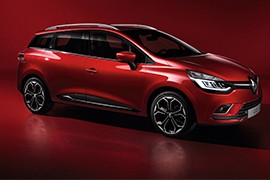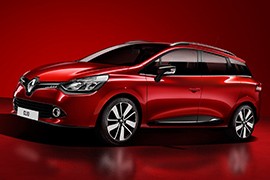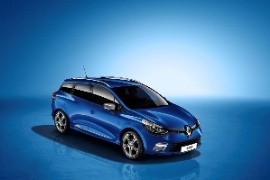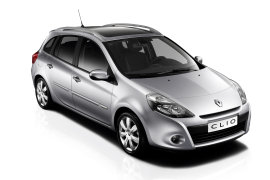RENAULT Clio Estate Models/Series Timeline, Specifications & Photos
First production year: 2009
Engines: Gasoline, Diesel
Body style: Wagon (station wagon, estate, combi, touring)
Renault introduced the fourth generation of the Clio in 2012 and refreshed-it in 2016. Along with the rest of the range, the French carmaker updated the station-wagon version as well.
After it dismissed the famous Renault 5, the French carmaker changed the lineup and introduced the Clio in 1990. In the beginning, it was available only as a 3- and 5-door hatchback. Later on, a sedan version (Renault Thalia/Clio Symbol) and a station-wagon joined the pack.
The French carmaker was dedicated to improving the safety of its products, and the Clio was no exception. For the 2016 model year, it received full-LED headlights as an option and LED daytime running lights. At the top of the upper grille, the carmaker installed a chromed bar. Renault names its facelifted models as "Phase II" (second stage). In the rear, the car received a new set of LED taillights. Both front and rear bumpers received a new design. The front featured an aggressive styling with an apron and side fog lights, and the Clio Estate's back featured a black lower side. For styling purposes, the carmaker offered a choice of five types of vinyl for the roof.
Inside, the carmaker introduced a new steering wheel with higher materials quality and, for the higher trim levels, it featured full grain leather. To complete the visual and tactile change, Renault installed new gear levers. The central air-vents received a new design as well. The rear bench was split-folding and could increase the trunk size from 366 liters (13 cu-ft) up to 1069 liters (37.7 cu-ft). For the 2016 model, Renault offered a new infotainment unit with a 7" touch screen placed on top of the center stack which allowed screen mirroring for smartphones.
Renault continued the Clio saga and introduced the fourth generation of this small-sized vehicle at the 2012 Paris Motor Show. While the five-door version was the first to hit the showroom floors, the station wagon, named Estate by the French carmaker, followed in 2013.
The Estate version was not always present in the lineup, but since the carmaker's design department managed to pen it like it was more of a hatchback, it succeeded.
There was a new, fresh front fascia that showed a pair of swept-back headlights connected via a chromed slat that crossed the hood. From its sides, the car shared the same body panels with the five-door hatchback version, but the rear doors were slightly modified and featured a door handle masked into the C-pillar. Behind it, a narrow third window ended the cabin into the raked-forward D-pillar. Depending on the trim level, that one was blackened.
Inside, the carmaker stated that it was room for five, although the narrow vehicle didn't provide too much shoulder or elbow room for those seated in the back. But the split-folding rear bench expanded the trunk enough to be used when moving out from the parents or coming back from the college. At the front, the carmaker installed two bucket seats trimmed in fabric, while the rounded dashboard was available in various colors, depending on the customers' options. The floating center stack design that supported the infotainment unit offered a minimalist design.
Under the hood, Renault installed a range of gasoline or turbo-diesel engines paired with either a five-speed manual or a six-speed automatic, depending on the powerplant.
Renault unveiled the fourth generation of the Clio range at the 2012 Paris Motor Show in both hatchback and station-wagon shapes.
Traditionally, it named the latter "Estate." Yes, it was a practical little car, especially for those looking for an affordable transportation solution but needing a larger trunk. But, to make it more attractive, it added a GT version.
Even in the non-GT shape, the Clio showed a sporty front fascia with swept-back headlights and a narrow grille that sported the chromed Renault logo. Unlike its regular sibling, the GT sported a new bumper with a trapezoidal lower grille flanked by side grilles that hosted the LED daytime running lights. The 17" light-alloy wheels with a special design were standard. In addition, Renault offered the Clio Estate GT in the Malte Blue color to emphasize the car's sporty look even more but left the door mirrors gray. Moreover, the car featured the same spoiler as the Clio RS at the back. Last but not least, a dual exhaust was placed under the rear bumper.
Transformations followed in the cabin, too, with GT lettering on the front seats' headrests. To diminish the reflections on the dashboard, the upper side sported a speckled gray finish, complementing the gray trim highlights. The driver could enjoy the standard R-Link infotainment unit with a touch-screen placed atop the center stack. Last but not least, the aluminum pedals were included in the GT package.
But Renault didn't limit its special version to the aesthetic changes and added a 1.2-liter turbocharged engine under the car's hood. It was mated to a seven-speed automatic (dual-clutch) gearbox dubbed EDC.
While most of the carmakers dropped the station-wagon versions for their small-sized vehicles, Renault counted on the Clio Estate to get good sales numbers, and they were right.
Usually, in the small-segment, most customers are looking for fuel-efficient, short, and easy-to-park vehicles. They don't really care about the trunk size or the split-folding seats. But the French carmaker identified a group of buyers among its clients that were still carving for a station-wagon based on a small vehicle. And it built it.
The new model showed a similar front fascia with its bigger brother, the Megane, from the outside. Its swept-back, curved headlights followed the lower grille line and continued it on the hood. It was a nice flowing exercise that made the car very appealing for specific customers. Its extended roofline and the three side windows might confuse some people if it was a shorter compact or a longer small vehicle. The curved tailgate was flanked on the sides by corner-mounted taillights, and the low-cut for in the bumper allowed users to quickly load and unload items.
Inside, the design team installed a curved dashboard covered with soft materials and silver plastic trims. The instrument cluster was carried over from the hatchback version and featured an LCD between the speedometer and tachometer. In the back, the carmaker installed a 60/40 split-folding bench, which allowed the trunk to be expanded from 439 liters (15.5 cu-ft) to 1277 liters (45 cu-ft).
Under the hood, Renault offered a choice of four engines, both gasoline and turbo-diesel, with up to eight power outputs, depending on the market.



